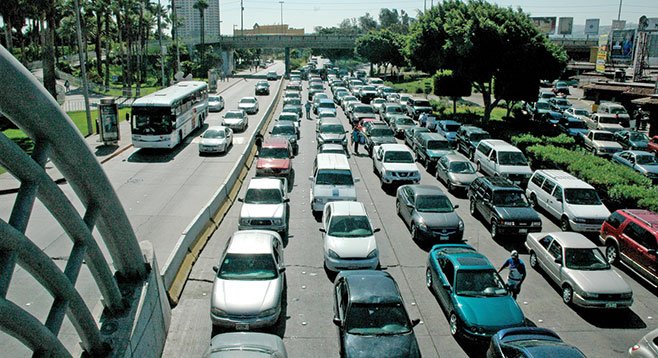 Facebook
Facebook
 X
X
 Instagram
Instagram
 TikTok
TikTok
 Youtube
Youtube

A little-noticed report by the inspector general’s office of the Federal Motor Carrier Safety Administration has found that software problems lasting almost a year, from September 2012 through August 2013, prevented U.S. state officials from uploading conviction reports of Mexican bus drivers. “The resulting backlog of conviction data could potentially delay enforcement action against some Mexican drivers that should be disqualified for moving violations, such as driving under the influence or excessive speeding,” the audit said.
In addition, the report, issued late last November, called out what it says is a deficient safety-inspection program that “does not adequately address bus inspection frequency or identify actions to eliminate inspection obstacles.” Noting “considerable bus traffic travels through United States-Mexico border crossings,” auditors said that, “most bus volume occurs at nine primary crossings in six counties located in California and Texas — representing 96 percent of bus entries and 94 percent of passenger entries. The highest volume county — San Diego, CA — represents almost half of all border entries.”
Annual average U.S.-bound bus entries in fiscal years 2011 and 2012 through the San Ysidro and Otay Mesa border gates, the report said, was 99,952, carrying a total of 687,164 passengers.
The auditors also found that the carrier safety administration’s inspection plan “does not specify whether weekend inspection coverage is required or how often inspectors should be on duty at high-volume crossings — some of which are open 24 hours a day, 7 days a week.” In particular, while “the plan notes the limitation produced by inadequate lighting at certain crossings, most notably at San Ysidro, CA, it does not identify potential actions to address this obstacle, such as adding portable lighting at these crossings.”
Compounding the problem, the audit said, was lack of agreement between the safety agency and U.S. Customs and Border Protection for “standard inspection protocols for safe and efficient bus inspections across the border.” Auditors found that “of the 27 passenger carrier crossings, only the Hidalgo, Texas, crossing had a written agreement with CBP establishing policies and procedures for inspecting vehicles and drivers and placing them out of service.”
Following issuance of the findings, safety-agency officials said they were fixing most of the problems and had begun talks with Customs and Border Protection on an inspection agreement, to be done by the end of this year. “However, [the carrier safety administration] stated that challenges, such as finite space at border locations, may prevent the Agency from achieving a final written agreement despite its best efforts.”


A little-noticed report by the inspector general’s office of the Federal Motor Carrier Safety Administration has found that software problems lasting almost a year, from September 2012 through August 2013, prevented U.S. state officials from uploading conviction reports of Mexican bus drivers. “The resulting backlog of conviction data could potentially delay enforcement action against some Mexican drivers that should be disqualified for moving violations, such as driving under the influence or excessive speeding,” the audit said.
In addition, the report, issued late last November, called out what it says is a deficient safety-inspection program that “does not adequately address bus inspection frequency or identify actions to eliminate inspection obstacles.” Noting “considerable bus traffic travels through United States-Mexico border crossings,” auditors said that, “most bus volume occurs at nine primary crossings in six counties located in California and Texas — representing 96 percent of bus entries and 94 percent of passenger entries. The highest volume county — San Diego, CA — represents almost half of all border entries.”
Annual average U.S.-bound bus entries in fiscal years 2011 and 2012 through the San Ysidro and Otay Mesa border gates, the report said, was 99,952, carrying a total of 687,164 passengers.
The auditors also found that the carrier safety administration’s inspection plan “does not specify whether weekend inspection coverage is required or how often inspectors should be on duty at high-volume crossings — some of which are open 24 hours a day, 7 days a week.” In particular, while “the plan notes the limitation produced by inadequate lighting at certain crossings, most notably at San Ysidro, CA, it does not identify potential actions to address this obstacle, such as adding portable lighting at these crossings.”
Compounding the problem, the audit said, was lack of agreement between the safety agency and U.S. Customs and Border Protection for “standard inspection protocols for safe and efficient bus inspections across the border.” Auditors found that “of the 27 passenger carrier crossings, only the Hidalgo, Texas, crossing had a written agreement with CBP establishing policies and procedures for inspecting vehicles and drivers and placing them out of service.”
Following issuance of the findings, safety-agency officials said they were fixing most of the problems and had begun talks with Customs and Border Protection on an inspection agreement, to be done by the end of this year. “However, [the carrier safety administration] stated that challenges, such as finite space at border locations, may prevent the Agency from achieving a final written agreement despite its best efforts.”
Comments